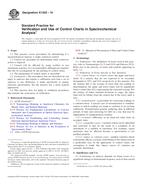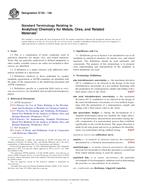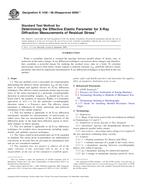Potřebujeme váš souhlas k využití jednotlivých dat, aby se vám mimo jiné mohly ukazovat informace týkající se vašich zájmů. Souhlas udělíte kliknutím na tlačítko „OK“.
ASTM G178-09
Standard Practice for Determining the Activation Spectrum of a Material (Wavelength Sensitivity to an Exposure Source) Using the Sharp Cut-On Filter or Spectrographic Technique
Automaticky přeložený název:
Standardní praktiky pro stanovení aktivační spektrum materiálu (Vlnová délka Citlivost ke zdroji expozice) Pomocí Sharp Cut s filtrem nebo spektrografickou Technika
NORMA vydána dne 15.4.2009
Informace o normě:
Označení normy: ASTM G178-09
Poznámka: NEPLATNÁ
Datum vydání normy: 15.4.2009
Kód zboží: NS-57540
Počet stran: 12
Přibližná hmotnost: 36 g (0.08 liber)
Země: Americká technická norma
Kategorie: Technické normy ASTM
Kategorie - podobné normy:
Anotace textu normy ASTM G178-09 :
Keywords:
activation spectrum, cumulative spectral sensitivity curve, degradation, light exposure, sharp cut-on filter technique, spectrographic technique, ultraviolet radiation, Actinic radiation, Activation energy, Light exposure, Sharp cut-on filter technique, Spectral distribution, Spectral response curve, Spectrographic analysis, Wavelength distribution, ICS Number Code 71.040.50 (Physicochemical methods of analysis)
Doplňující informace
| Significance and Use | ||||||||||||||||||||||||||||||||||||||||||||||||||||||||
|
The activation spectrum identifies the spectral region(s) of the specific exposure source used that may be primarily responsible for changes in appearance and/or physical properties of the material. The spectrographic technique uses a prism or grating spectrograph to determine the effect on the material of isolated narrow spectral bands of the light source, each in the absence of other wavelengths. The sharp cut-on filter technique uses a specially designed set of sharp cut-on UV/visible transmitting glass filters to determine the relative actinic effects of individual spectral bands of the light source during simultaneous exposure to wavelengths longer than the spectral band of interest. Both the spectrographic and filter techniques provide activation spectra, but they differ in several respects: The spectrographic technique generally provides better resolution since it determines the effects of narrower spectral portions of the light source than the filter technique. The filter technique is more representative of the polychromatic radiation to which samples are normally exposed with different, and sometimes antagonistic, photochemical processes often occurring simultaneously. However, since the filters only transmit wavelengths longer than the cut-on wavelength of each filter, antagonistic processes by wavelengths shorter than the cut-on are eliminated. In the filter technique, separate specimens are used to determine the effect of the spectral bands and the specimens are sufficiently large for measurement of both mechanical and optical changes. In the spectrographic technique, except in the case of spectrographs as large as the Okazaki type (1), a single small specimen is used to determine the relative effects of all the spectral bands. Thus, property changes are limited to those that can be measured on very small sections of the specimen. The information provided by activation spectra on the spectral region of the light source responsible for the degradation in theory has application to stabilization as well as to stability testing of polymeric materials (2). Activation spectra based on exposure of the unstabilized material to solar radiation identify the light screening requirements and thus the type of ultraviolet absorber to use for optimum screening protection. The closer the match of the absorption spectrum of a UV absorber to the activation spectrum of the material, the more effective the screening. However, a good match of the UV absorption spectrum of the UV absorber to the activation spectrum does not necessarily assure adequate protection since it is not the only criteria for selecting an effective UV absorber. Factors such as dispersion, compatibility, migration and others can have a significant influence on the effectiveness of a UV absorber (see Note 3). The activation spectrum must be determined using a light source that simulates the spectral power distribution of the one to which the material will be exposed under use conditions. Note 3—In a study by ASTM G03.01, the activation spectrum of a copolyester based on exposure to borosilicate glass-filtered xenon arc radiation predicted that UV absorber A would be superior to UV absorber B in outdoor use because of stronger absorption of the harmful wavelengths of solar simulated radiation. However, both additives protected the copolyester to the same extent when exposed either to xenon arc radiation or outdoors. Comparison of the activation spectrum of the stabilized with that of the unstabilized material provides information on the completeness of screening and identifies any spectral regions that are not adequately screened. Comparison of the activation spectrum of a material based on solar radiation with those based on exposure to other types of light sources provides information useful in selection of the appropriate artificial test source. An adequate match of the harmful wavelengths of solar radiation by the latter is required to simulate the effects of outdoor exposure. Differences between the natural and artificial source in the wavelengths that cause degradation can result in different mechanisms and type of degradation. Published data have shown that better correlations can be obtained between natural weathering tests under different seasonal conditions when exposures are timed in terms of solar UV radiant exposure only rather than total solar radiant exposure. Timing exposures based on only the portion of the UV identified by the activation spectrum to be harmful to the material can further improve correlations. However, while it is an improvement over the way exposures are currently timed, it does not take into consideration the effect of moisture and temperature. Over a long test period, the activation spectrum will register the effect of the different spectral power distributions caused by lamp or filter aging or daily or seasonal variation in solar radiation. In theory, activation spectra may vary with differences in sample temperature. However, similar activation spectra have been obtained at ambient temperature (by the spectrographic technique) and at about 65°C (by the filter technique) using the same type of radiation source. |
||||||||||||||||||||||||||||||||||||||||||||||||||||||||
| 1. Scope | ||||||||||||||||||||||||||||||||||||||||||||||||||||||||
|
1.1 This practice describes the determination of the relative actinic effects of individual spectral bands of an exposure source on a material. The activation spectrum is specific to the light source to which the material is exposed to obtain the activation spectrum. A light source with a different spectral power distribution will produce a different activation spectrum. 1.2 This practice describes two procedures for determining an activation spectrum. One uses sharp cut-on UV/visible transmitting filters and the other uses a spectrograph to determine the relative degradation caused by individual spectral regions. Note 1—Other techniques can be used to isolate the effects of individual spectral bands of a light source, for example, interference filters. 1.3 The techniques are applicable to determination of the spectral effects of solar radiation and laboratory accelerated test devices on a material. They are described for the UV region, but can be extended into the visible region using different cut-on filters and appropriate spectrographs. 1.4 The techniques are applicable to a variety of materials, both transparent and opaque, including plastics, paints, inks, textiles and others. 1.5 The optical and/or physical property changes in a material can be determined by various appropriate methods. The methods of evaluation are beyond the scope of this practice. 1.6 This standard does not purport to address all of the safety concerns, if any, associated with its use. It is the responsibility of the user of this standard to establish appropriate safety and health practices and determine the applicability of regulatory limitations prior to use. Note 2—There is no ISO standard that is equivalent to this standard. |
||||||||||||||||||||||||||||||||||||||||||||||||||||||||
| 2. Referenced Documents | ||||||||||||||||||||||||||||||||||||||||||||||||||||||||
|
Podobné normy:
Historická
1.11.2010
Historická
1.3.2010
Historická
1.10.2010
Historická
15.8.2014
Historická
15.1.2007
Historická
1.6.2009
Doporučujeme:
Aktualizace technických norem
Chcete mít jistotu, že používáte pouze platné technické normy?
Nabízíme Vám řešení, které Vám zajistí měsíční přehled o aktuálnosti norem, které používáte.
Chcete vědět více informací? Podívejte se na tuto stránku.



 ASTM E1303-95(2010)..
ASTM E1303-95(2010).. ASTM E131-10
ASTM E131-10 ASTM E1329-10
ASTM E1329-10 ASTM E135-14b
ASTM E135-14b ASTM E1361-02(2007)..
ASTM E1361-02(2007).. ASTM E1426-98(2009)e..
ASTM E1426-98(2009)e..
 Cookies
Cookies
